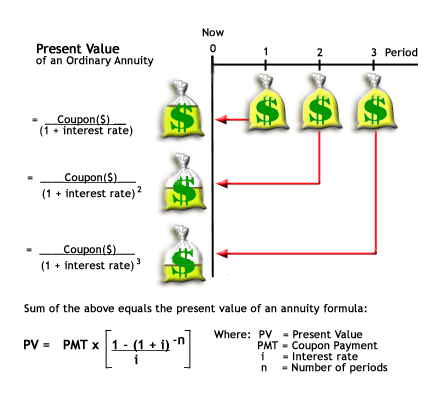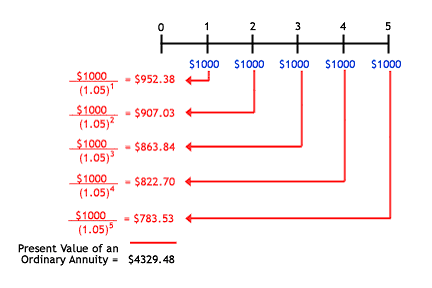What are Present Value and Future Value
Post on: 16 Март, 2015 No Comment

What are Present Value and Future Value
Subscribe to EconGuru:
Finance is all about time and risk. Its basically a study of how people make decisions regarding the allocation of resources over time and the handling of risks of them . Playing with it requires some very fundamental techniques and strategies, which are all indispensable if not enough for success in financial markets. And the idea of present value is one of the most important that will help you value financial assets over time thus making choices between current resources and future gains.
First off, money today is always more valuable than the same amount of money future. This is because you can always deposit that money in bank and roll it into a bigger amount by earning interest. In this sense, with $100 deposited in bank today on a interest rate of 4% or 0.04, in 3 years you will have
$100 * (1+0.04) 3 = $112.5
Therefore, the present value of $112.5 3 years from now is $100 . You get the idea.
Present value is the amount of money today that would be needed to produce, using prevailing interest rates, a given future amount of money.
Conversely, future value is the amount of money in future that a certain amount of money today will yield, given prevailing interest rates.
In the example of $100, the future value of $100 after 3 years is $112.5 .
MFV = (1 + r) N * MPV
Now suppose you are going to be paid $1200 10 years from now, what is the present value of this future payment? Considering the above formula and guessing with all the information available that the average annual interest rate will probably remain at 5%, we have
MPV = MFV / (1 + r) N = $1200 / (1 + 0.05) 10 = $736.6
So, the present value of the $1200 payment after 10 years is $736.6. In other words, its only worth of $736.6 in todays money.
To help you smoothly use the concept in real situations, lets walk through 2 examples.
Example 1
The concept of present value is very important and applied frequently in financial decision-making. For instance, Microsoft is thinking of investing $100 millions today to the development of Windows Live Search to rival Google. and estimates that the yield of the project in 5 years is $140 millions. Should the software giant go ahead with the investment?
The companys decision, is very much dependent on the estimation of future interest rate. If the interest rate is 4%, the present value of $140 millions 5 years from now would be
MPV = MFV / (1 + r) N = 140 / (1 + 0.04) 5 = 115.1, in million
Apparently, the project is profitable and they should choose to invest the $100 millions now because the future gains(converted to present value of 115.1 millions, which is bigger than 100 millions) is bigger than the current investment cost. However, if they have guessed an annual average interest rate of 7%, it will be hardly profitable because,
MPV = MFV / (1 + r) N = 140 / (1 + 0.07) 5 = 99.8, in million
Thus, with interest rate of 7% and higher, the present value of the return will not be able to cover the cost today. Its wise of them to keep away from the project.

Example 2
In this example, things are a little more complicated in that you will have to determine the present value of a stream of payments rather than one, which is more common in reality.
Imagine that you have won a million-dollar lottery and is asked to choose between being paid $25,000 a year for 40 years or an immediate payment of $500,000. So which is the right choice at an annual interest rate of 4% for the next 40 years?
With a stream of simple calculations of present value, you will make the right choice in no time. Suppose the payment starts the following year for 40 years, we have
1st year: MPV1 = MFV1 / (1 + r) N = 25,000 / (1 + 0.04) 1 = 24,038
2nd year: MPV2 = MFV2 / (1 + r) N = 25,000 / (1 + 0.04) 2 = 23,114
3rd year: MPV3 = MFV3 / (1 + r) N = 25,000 / (1 + 0.04) 3 = 22,225
40th year: MPV40 = MFV40 /(1 + r) N = 25,000/(1 + 0.04) 40 =5,207
Total: 494,819
Adding 24,038 + 23,114 + 22,225 + + 5,207, we have the final present value of the 40 years stream of payments, $494,819, which is a little smaller than $500,000.
Therefore, based on a series of present value calculations, an immediate payment of $500,000 is more favorable over getting paid $25,000 a year for 40 years.














